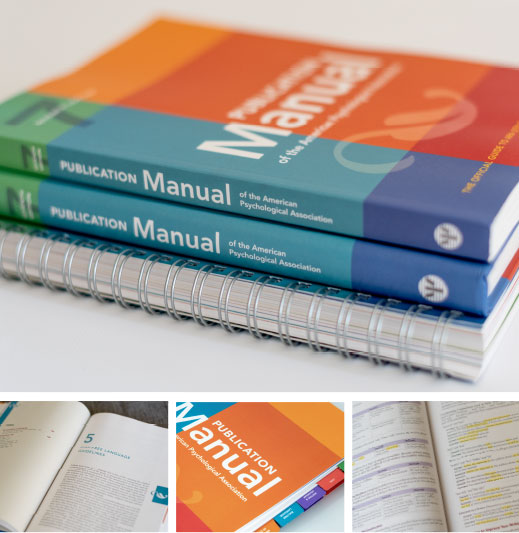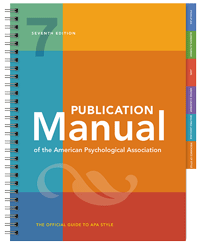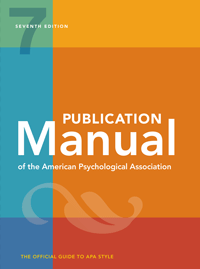Texas Family Law Practice Manual (3rd Ed.), Form 7-1

Official Source for APA Style
The Publication Manual of the American Psychological Association, 7th Edition is the official source for APA Style.
Widely Adopted
With millions of copies sold worldwide in multiple languages, it is the way transmission of selection for writers, researchers, editors, students, and educators in the social and behavioral sciences, natural sciences, nursing, communications, education, business, technology, and other fields.
Authoritative and Easy to Use
Known for its authoritative, piece of cake-to-use reference and citation system, the Publication Transmission also offers guidance on choosing the headings, tables, figures, language, and tone that will effect in powerful, concise, and elegant scholarly communication.
Scholarly Writing
It guides users through the scholarly writing process—from the ethics of authorship to reporting enquiry through publication.
- Screw-Leap $44.99
- Paperback $31.99
- Hardcover $54.99
- Ebooks
- Course Adoption
Spiral-Bound $44.99
 Spiral-Bound Features
Spiral-Bound Features
• Full color
• Piece of cake-access sections with colour-coded tabs
• Lies flat for easy handling
Buy
Paperback $31.99
 Paperback Features
Paperback Features
• Full colour
• Affordable
• Lightweight and travel friendly
Purchase
Hardcover $54.99
 Hardcover Features
Hardcover Features
• Full color
• Extra durable
• Shelf friendly
Purchase
Ebooks
 Ebook is bachelor for purchase or hire from your choice of vendor.
Ebook is bachelor for purchase or hire from your choice of vendor.
Ebook Features
• Searchable
• Read anywhere
• Highlight and annotate
Course Adoption
It is an indispensable resources for students and professionals to achieve excellence in writing and brand an impact with their work.
7 Reasons Why Everyone Needs the 7th Edition of APA'due south Bestselling Publication Transmission
What's New in the 7th Edition?
Full Color
All formats are in full color, including the new tabbed screw-jump version.
Easy to Navigate
Improved ease of navigation, with many additional numbered sections to help users quickly locate answers to their questions.
All-time Practices
The Publication Transmission (seventh ed.) has been thoroughly revised and updated to reflect all-time practices in scholarly writing and publishing.
New Educatee Resources
Resources for students on writing and formatting annotated bibliographies, response papers, and other paper types as well as guidelines on citing course materials.
Accessibility Guidelines
Guidelines that support accessibility for all users, including simplified reference, in-text citation, and heading formats every bit well as additional font options.
New-User Content
Defended affiliate for new users of APA Style roofing paper elements and format, including sample papers for both professional authors and pupil writers.
Periodical Article Reporting Standards
New chapter on journal article reporting standards that includes updates to reporting standards for quantitative research and the first-ever qualitative and mixed methods reporting standards in APA Style.
Bias-Gratis Linguistic communication Guidelines
New chapter on bias-costless language guidelines for writing about people with respect and inclusivity in areas including historic period, disability, gender, participation in enquiry, race and ethnicity, sexual orientation, socioeconomic status, and intersectionality
100+ Reference Examples
More than than 100 new reference examples covering periodicals, books, audiovisual media, social media, webpages and websites, and legal resource.
40+ New Sample Tables and Figures
More than 40 new sample tables and figures, including student-friendly examples such as a correlation table and a bar nautical chart as well as examples that evidence how to reproduce a table or effigy from some other source.
Ethics Expanded
Expanded guidance on ethical writing and publishing practices, including how to ensure the advisable level of citation, avoid plagiarism and self-plagiarism, and navigate the publication process.
7th Edition Tabular array of Contents
- Front Thing
- ane. Scholarly Writing and Publishing Principles
- 2. Paper Elements and Format
- 3. Journal Article Reporting Standards
- 4. Writing Style and Grammar
- v. Bias-Costless Language Guidelines
- half dozen. Mechanics of Style
- 7. Tables and Figures
- 8. Works Credited in the Text
- 9. Reference Listing
- x. Reference Examples
- eleven. Legal References
- 12. Publication Procedure
- Back Thing
Front Affair
List of Tables and Figures
Editorial Staff and Contributors
Acknowledgments
Introduction (PDF, 94KB)
Why Use APA Style?
APA Fashion for Students
Utility and Accessibility
What's New in the Seventh Edition?
APA Style Online
Notes to Users
one. Scholarly Writing and Publishing Principles
Types of Articles and Papers
1.1 Quantitative Articles
i.2 Qualitative Articles
1.3 Mixed Methods Articles
1.4 Replication Manufactures
1.5 Quantitative and Qualitative Meta-Analyses
one.6 Literature Review Manufactures
1.7 Theoretical Articles
1.viii Methodological Articles
1.ix Other Types of Articles
one.10 Student Papers, Dissertations, and Theses
Ethical, legal, and professional standards in publishing
Ensuring the Accuracy of Scientific Findings
one.11 Planning for Upstanding Compliance
i.12 Upstanding and Authentic Reporting of Enquiry Results
1.13 Errors, Corrections, and Retractions After Publication
1.xiv Data Retentivity and Sharing
1.xv Boosted Data-Sharing Considerations for Qualitative Enquiry
1.xvi Indistinguishable and Piecemeal Publication of Information
1.17 Implications of Plagiarism and Self-Plagiarism
Protecting the Rights and Welfare of Research Participants and Subjects
ane.18 Rights and Welfare of Research Participants and Subjects
1.nineteen Protecting Confidentiality
1.20 Conflict of Interest
Protecting Intellectual Property Rights
1.21 Publication Credit
ane.22 Gild of Authors
1.23 Authors' Intellectual Property Rights During Manuscript Review
one.24 Authors' Copyright on Unpublished Manuscripts
1.25 Ethical Compliance Checklist
two. Paper Elements and Format
Required Elements
2.ane Professional Newspaper Required Elements
ii.2 Student Paper Required Elements
Newspaper Elements
ii.three Title Page
ii.4 Title
ii.v Author Name (Byline)
two.6 Author Affiliation
2.vii Author Note
two.eight Running Head
2.9 Abstract
2.x Keywords
2.eleven Text (Trunk)
ii.12 Reference Listing
2.13 Footnotes
2.xiv Appendices
2.15 Supplemental Materials
Format
2.sixteen Importance of Format
two.17 Order of Pages
ii.xviii Folio Header
2.19 Font
ii.20 Special Characters
2.21 Line Spacing
2.22 Margins
2.23 Paragraph Alignment
2.24 Paragraph Indentation
2.25 Paper Length
System
2.26 Principles of Organization
2.27 Heading Levels
ii.28 Section Labels
Sample papers
three. Periodical Article Reporting Standards
Overview of Reporting Standards
3.i Application of the Principles of JARS
3.2 Terminology Used in JARS
Common Reporting Standards Across Research Designs
3.three Abstruse Standards
iii.four Introduction Standards
Reporting Standards for Quantitative Research
iii.v Bones Expectations for Quantitative Research Reporting
3.6 Quantitative Method Standards
3.seven Quantitative Results Standards
3.8 Quantitative Give-and-take Standards
iii.9 Additional Reporting Standards for Typical Experimental and Nonexperimental Studies
3.ten Reporting Standards for Special Designs
iii.xi Standards for Analytic Approaches
3.12 Quantitative Meta-Analysis Standards
Reporting Standards for Qualitative Research
three.thirteen Bones Expectations for Qualitative Research Reporting
3.fourteen Qualitative Method Standards
3.fifteen Qualitative Findings or Results Standards
three.16 Qualitative Discussion Standards
3.17 Qualitative Meta-Assay Standards
Reporting Standards for Mixed Methods Research
3.18 Basic Expectations for Mixed Methods Inquiry Reporting
iv. Writing Style and Grammar
Effective scholarly writing
Continuity and Catamenia
4.1 Importance of Continuity and Catamenia
4.ii Transitions
four.3 Noun Strings
Conciseness and Clarity
4.four Importance of Conciseness and Clarity
4.5 Wordiness and Redundancy
4.6 Sentence and Paragraph Length
4.7 Tone
4.viii Contractions and Colloquialisms
4.nine Jargon
4.10 Logical Comparisons
4.11 Anthropomorphism
Grammar and usage
Verbs
4.12 Verb Tense
four.13 Active and Passive Phonation
4.14 Mood
four.15 Bailiwick and Verb Agreement
Pronouns
4.16 Beginning- Versus Third-Person Pronouns
4.17 Editorial "We"
iv.18 Singular "They"
four.nineteen Pronouns for People and Animals ("Who" vs. "That")
4.20 Pronouns every bit Subjects and Objects ("Who" vs. "Whom")
4.21 Pronouns in Restrictive and Nonrestrictive Clauses ("That" vs. "Which")
Sentence Structure
four.22 Subordinate Conjunctions
4.23 Misplaced and Dangling Modifiers
4.24 Parallel Construction
Strategies to Meliorate Your Writing
4.25 Reading to Learn Through Example
iv.26 Writing From an Outline
iv.27 Rereading the Draft
4.28 Seeking Aid From Colleagues
iv.29 Working With Copyeditors and Writing Centers
4.thirty Revising a Newspaper
5. Bias-Free Linguistic communication Guidelines
General Guidelines for Reducing Bias
5.1 Describe at the Appropriate Level of Specificity
v.2 Be Sensitive to Labels
Reducing Bias by Topic
5.3 Historic period
five.4 Disability
five.five Gender
5.6 Participation in Research
5.vii Racial and Ethnic Identity
v.eight Sexual Orientation
5.9 Socioeconomic Condition
5.10 Intersectionality
vi. Mechanics of Way
Punctuation
6.1 Spacing After Punctuation Marks
half dozen.2 Period
6.three Comma
vi.4 Semicolon
vi.five Colon
6.6 Dash
6.7 Quotation Marks
half dozen.8 Parentheses
half-dozen.9 Foursquare Brackets
6.10 Slash
Spelling
6.11 Preferred Spelling
six.12 Hyphenation
Capitalization
half-dozen.13 Words First a Sentence
6.14 Proper Nouns and Merchandise Names
6.15 Job Titles and Positions
six.16 Diseases, Disorders, Therapies, Theories, and Related Terms
half-dozen.17 Titles of Works and Headings Within Works
6.eighteen Titles of Tests and Measures
6.19 Nouns Followed by Numerals or Messages
6.20 Names of Atmospheric condition or Groups in an Experiment
6.21 Names of Factors, Variables, and Effects
Italics
6.22 Utilize of Italics
vi.23 Reverse Italics
Abbreviations
6.24 Apply of Abbreviations
6.25 Definition of Abbreviations
half dozen.26 Format of Abbreviations
6.27 Unit of measurement Abbreviations
half-dozen.28 Time Abbreviations
6.29 Latin Abbreviations
half-dozen.30 Chemic Chemical compound Abbreviations
6.31 Factor and Protein Name Abbreviations
Numbers
6.32 Numbers Expressed in Numerals
six.33 Numbers Expressed in Words
half-dozen.34 Combining Numerals and Words to Limited Numbers
6.35 Ordinal Numbers
half-dozen.36 Decimal Fractions
six.37 Roman Numerals
six.38 Commas in Numbers
6.39 Plurals of Numbers
Statistical and Mathematical Copy
half dozen.40 Selecting Effective Presentation
6.41 References for Statistics
half dozen.42 Formulas
6.43 Statistics in Text
6.44 Statistical Symbols and Abbreviations
half-dozen.45 Spacing, Alignment, and Punctuation for Statistics
Presentation of Equations
6.46 Equations in Text
six.47 Displayed Equations
6.48 Preparing Statistical and Mathematical Re-create for Publication
Lists
6.49 List Guidelines
6.fifty Lettered Lists
6.51 Numbered Lists
6.52 Bulleted Lists
7. Tables and Figures
General Guidelines for Tables and Figures
vii.1 Purpose of Tables and Figures
7.2 Design and Preparation of Tables and Figures
seven.iii Graphical Versus Textual Presentation
vii.iv Formatting Tables and Figures
7.v Referring to Tables and Figures in the Text
vii.half dozen Placement of Tables and Figures
seven.seven Reprinting or Adapting Tables and Figures
Tables
7.viii Principles of Table Construction
7.9 Table Components
seven.10 Tabular array Numbers
7.11 Tabular array Titles
7.12 Table Headings
7.13 Table Body
7.xiv Table Notes
seven.15 Standard Abbreviations in Tables and Figures
vii.16 Conviction Intervals in Tables
vii.17 Tabular array Borders and Shading
seven.18 Long or Wide Tables
7.19 Relation Between Tables
7.xx Table Checklist
seven.21 Sample Tables
Sample tables
Figures
seven.22 Principles of Figure Construction
seven.23 Effigy Components
seven.24 Figure Numbers
seven.25 Figure Titles
7.26 Figure Images
7.27 Figure Legends
seven.28 Figure Notes
7.29 Relation Between Figures
seven.xxx Photographs
7.31 Considerations for Electrophysiological, Radiological, Genetic, and Other Biological Data
7.32 Electrophysiological Data
vii.33 Radiological (Imaging) Data
seven.34 Genetic Data
7.35 Figure Checklist
7.36 Sample Figures
Sample figures
eight. Works Credited in the Text
General Guidelines for Citation
8.1 Appropriate Level of Commendation
viii.two Plagiarism
eight.3 Self-Plagiarism
8.4 Correspondence Betwixt Reference List and Text
8.five Use of the Published Version or Archival Version
8.vi Primary and Secondary Sources
Works Requiring Special Approaches to Citation
8.7 Interviews
8.8 Classroom or Intranet Sources
8.9 Personal Communications
In-Text Citations
8.x Author–Date Commendation Organization
8.11 Parenthetical and Narrative Citations
8.12 Citing Multiple Works
8.13 Citing Specific Parts of a Source
8.14 Unknown or Anonymous Author
8.15 Translated, Reprinted, Republished, and Reissued Dates
8,sixteen Omitting the Twelvemonth in Repeated Narrative Citations
viii.17 Number of Authors to Include in In-Text Citations
8.xviii Avoiding Ambiguity in In-Text Citations
8.19 Works With the Same Writer and Same Date
8.xx Authors With the Aforementioned Surname
8.21 Abbreviating Group Authors
viii.22 General Mentions of Websites, Periodicals, and Mutual Software and Apps
Paraphrases and Quotations
eight.23 Principles of Paraphrasing
eight.24 Long Paraphrases
8.25 Principles of Direct Quotation
viii.26 Curt Quotations (Fewer Than 40 Words)
viii.27 Cake Quotations (twoscore Words or More than)
viii.28 Direct Quotation of Material Without Page Numbers
viii.29 Accuracy of Quotations
viii.30 Changes to a Quotation Requiring No Explanation
8.31 Changes to a Quotation Requiring Explanation
viii.32 Quotations That Comprise Citations to Other Works
eight.33 Quotations That Contain Textile Already in Quotation Marks
8.34 Permission to Reprint or Adapt Lengthy Quotations
8.35 Epigraphs
viii.36 Quotations From Research Participants
9. Reference List
Reference Categories
nine.1 Determining the Reference Category
nine.two Using the Webpages and Websites Reference Category
9.3 Online and Impress References
Principles of Reference List Entries
ix.4 Four Elements of a Reference
9.v Punctuation Within Reference List Entries
9.6 Accuracy and Consistency in References
Reference elements
Author
9.7 Definition of Author
ix.eight Format of the Writer Element
nine.9 Spelling and Capitalization of Author Names
9.10 Identification of Specialized Roles
9.11 Group Authors
9.12 No Author
Date
ix.13 Definition of Date
9.14 Format of the Date Element
nine.xv Updated or Reviewed Online Works
9.xvi Retrieval Dates
ix.17 No Engagement
Title
9.18 Definition of Championship
9.19 Format of the Title Chemical element
9.20 Serial and Multivolume Works
9.21 Bracketed Descriptions
nine.22 No Title
Source
9.23 Definition of Source
ix.24 Format of the Source Element
9.25 Periodical Sources
nine.26 Online Periodicals With Missing Information
9.27 Commodity Numbers
9.28 Edited Book Affiliate and Reference Work Entry Sources
9.29 Publisher Sources
9.xxx Database and Archive Sources
9.31 Works With Specific Locations
9.32 Social Media Sources
9.33 Website Sources
9.34 When to Include DOIs and URLs
9.35 Format of DOIs and URLs
9.36 DOI or URL Shorteners
nine.37 No Source
Reference Variations
9.38 Works in Another Language
9.39 Translated Works
ix.40 Reprinted Works
9.41 Republished or Reissued Works
ix.42 Religious and Classical Works
Reference List Format and Lodge
nine.43 Format of the Reference List
9.44 Society of Works in the Reference Listing
9.45 Order of Surname and Given Name
9.46 Society of Multiple Works past the Same Start Writer
ix.47 Society of Works With the Same Writer and Same Date
9.48 Social club of Works by Get-go Authors With the Same Surname
ix.49 Guild of Works With No Author or an Anonymous Writer
9.fifty Abbreviations in References
nine.51 Annotated Bibliographies
9.52 References Included in a Meta-Analysis
ten. Reference Examples
Author Variations
Date Variations
Title Variations
Source Variations
Textual Works
10.ane Periodicals
10.ii Books and Reference Works
ten.3 Edited Volume Capacity and Entries in Reference Works
10.4 Reports and Grey Literature
10.5 Briefing Sessions and Presentations
x.6 Dissertations and Theses
10.7 Reviews
x.eight Unpublished Works and Informally Published Works
Data Sets, Software, and Tests
x.9 Data Sets
10.x Reckoner Software, Mobile Apps, Apparatuses, and Equipment
ten.11 Tests, Scales, and Inventories
Audiovisual Media
x.12 Audiovisual Works
x.xiii Audio Works
ten.fourteen Visual Works
Online Media
ten.15 Social Media
ten.xvi Webpages and Websites
xi. Legal References
General Guidelines for Legal References
11.1 APA Style References Versus Legal References
11.ii General Forms
xi.3 In-Text Citations of Legal Materials
Legal Reference Examples
xi.4 Cases or Court Decisions
11.5 Statutes (Laws and Acts)
11.six Legislative Materials
11.7 Administrative and Executive Materials
11.eight Patents
11.9 Constitutions and Charters
eleven.10 Treaties and International Conventions
12. Publication Process
Preparing for Publication
12.1 Adapting a Dissertation or Thesis Into a Periodical Article
12.2 Selecting a Journal for Publication
12.three Prioritizing Potential Journals
12.4 Avoiding Predatory Journals
Understanding the Editorial Publication Procedure
12.5 Editorial Publication Procedure
12.6 Role of the Editors
12.7 Peer Review Process
12.8 Manuscript Decisions
Manuscript Training
12.9 Preparing the Manuscript for Submission
12.10 Using an Online Submission Portal
12.11 Writing a Encompass Letter of the alphabet
12.12 Respective During Publication
12.13 Certifying Ethical Requirements
Copyright and Permission Guidelines
12.xiv General Guidelines for Reprinting or Adapting Materials
12.15 Materials That Require Copyright Attribution
12.sixteen Copyright Status
12.17 Permission and Fair Use
12.eighteen Copyright Attribution Formats
During and Subsequently Publication
12.nineteen Article Proofs
12.20 Published Article Copyright Policies
12.21 Open Admission Deposit Policies
12.22 Writing a Correction Notice
12.23 Sharing Your Article Online
12.24 Promoting Your Commodity
Back Matter
Credits for Adapted Tables, Figures, and Papers
References
Index
bartlettguile1953.blogspot.com
Source: https://apastyle.apa.org/products/publication-manual-7th-edition
Publicar un comentario for "Texas Family Law Practice Manual (3rd Ed.), Form 7-1"